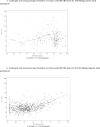Determination of hepatitis B phenotype using biochemical and serological markers
- PMID: 27917600
- PMCID: PMC5733779
- DOI: 10.1111/jvh.12643
Determination of hepatitis B phenotype using biochemical and serological markers
Abstract
The aim of this study was to assess the validity of categorization of chronic hepatitis B viral infection into stages or phases based upon measures of disease activity and viral load, assuming these phenotypes will be useful for prognostication and determining the need for antiviral therapy. We assessed the phenotype of hepatitis B of 1,390 adult participants enrolled in the Hepatitis B Research Network Cohort Study, using a computer algorithm. Only 4% were immune tolerant, while 35% had chronic hepatitis B (18% e antigen positive and 17% e antigen negative) while 23% were inactive carriers. Strikingly, 38% of participants did not fit clearly into any one of these groups and were considered indeterminant. The largest subset of indeterminants had elevated serum aminotransferases with low levels of HBV DNA (less than 10,000 iu/mL). Subsequent determination of hepatitis B phenotype on the next available laboratory tests showed that 64% remained indeterminant. These findings call into question the validity of conventional staging of hepatitis B, in large part because of the substantial proportion of patients who do not fit readily into one of the usual stages or phases. Further studies are needed of the indeterminant category of chronic hepatitis B viral infection, including assessments of whether patients in this group are perhaps in transition to another phase or if they are a distinct phenotype with a need to assess liver disease severity and need for antiviral therapy. (ClinicalTrials.gov identifier NCT01263587).
Keywords: algorithm; hepatitis B; phases; phenotype; stages.
© 2016 John Wiley & Sons Ltd.
Conflict of interest statement
No authors have any relevant financial disclosures or other conflicts of interest.
Figures



References
-
- Sorrell MF, Belongia EA, Costa J, et al. T. National Institutes of Health Consensus Development Conference Statement: management of hepatitis B. Annals of Internal Medicine. 2009;150:104–10. - PubMed
-
- Chen CJ, Yang HI, Su J, et al. Risk of hepatocellular carcinoma across a biological gradient of serum hepatitis B virus DNA level. JAMA. 2006;295:65–73. - PubMed
-
- Lok AS, McMahon BJ. Chronic hepatitis B: update 2009. Hepatology. 2009;50:661–2. - PubMed
-
- European Association For The Study Of The Liver. EASL clinical practice guidelines: Management of chronic hepatitis B virus infection. J Hepatol. 2012;57:167–85. - PubMed
-
- Liaw YF, Kao JH, Piratvisuth T, et al. Asian-Pacific consensus statement on the management of chronic hepatitis B: A 2012 update. Hepatology International. 2012;6:531–61. - PubMed
Publication types
MeSH terms
Substances
Associated data
Grants and funding
- U01 DK082919/DK/NIDDK NIH HHS/United States
- U01 DK082927/DK/NIDDK NIH HHS/United States
- U01 DK082872/DK/NIDDK NIH HHS/United States
- UL1 TR001111/TR/NCATS NIH HHS/United States
- U01 DK082943/DK/NIDDK NIH HHS/United States
- P30 DK050306/DK/NIDDK NIH HHS/United States
- M01 RR000040/RR/NCRR NIH HHS/United States
- U01 DK082923/DK/NIDDK NIH HHS/United States
- U01 DK082871/DK/NIDDK NIH HHS/United States
- U01 DK082944/DK/NIDDK NIH HHS/United States
- U01 DK082864/DK/NIDDK NIH HHS/United States
- UL1 TR000058/TR/NCATS NIH HHS/United States
- M01 RR000400/RR/NCRR NIH HHS/United States
- U01 DK082867/DK/NIDDK NIH HHS/United States
- U01 DK082843/DK/NIDDK NIH HHS/United States
- U01 DK082863/DK/NIDDK NIH HHS/United States
- U01 DK082874/DK/NIDDK NIH HHS/United States
- UL1 TR000004/TR/NCATS NIH HHS/United States
- U01 DK082866/DK/NIDDK NIH HHS/United States
- UL1 RR024986/RR/NCRR NIH HHS/United States
LinkOut - more resources
Full Text Sources
Other Literature Sources
Medical
Miscellaneous

